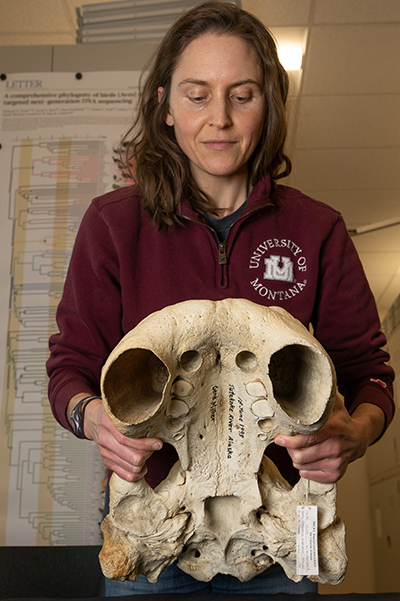UM Museum Home to Collection of Creatures Big and Small
MISSOULA – A set of rooms quietly tucked away at the University of Montana houses a zoological collection of animals specimens so vast, its reputation reaches worldwide.
Some 22,000 intact specimens reside in the Philip L. Wright Zoological Museum, including thousands upon thousands of claws, clavicles and cranial pieces from animals as diverse as grizzly bears, pelicans, kangaroos and hummingbirds.
Now in its 126th year of operation, the museum is both a time capsule of species from decades past and a living laboratory for students and researchers to study biodiversity, anatomy, evolution and emerging diseases.

Museum curator Angela Hornsby holds one of the museum’s larger specimens, a walrus skull. The museum boasts other hefty items, including a moose pelt and elephant tooth.
“Our specimens give us a snapshot in time,” said museum curator Angela Hornsby as she opens a drawer lined with toucans and other vibrantly hued birds. “This isn’t just a loon chick – it’s a loon chick from a specific place and time. With it, we can ask questions not only about growth and development of loons, but we can ask questions about the population it was in and what the environment was like at that time.”
Every specimen that comes into the collection – some are donated by other collections, some from researchers and many from the public – goes through a prep and preservation room staffed by students and volunteers, all members of an appropriately named Carcass Club. (One of its more famous alums is Emily Graslie, star of the popular science YouTube series “The Brain Scoop,” whose work inspired UM to start an internship program to support interdisciplinary student projects in the museum.)
The center of attention for most visitors to the prep room is a desk-sized plastic box that’s home to a carcass-cleaning crew of Dermestid beetles, known for their ability to strip a skull to the bone in just a few days and a favored tool of taxidermists. The beetles spend their entire life cycle in the lab’s box, breeding, laying eggs and eating.
“This colony has been going strong for at least 15 years,” said Hornsby. “They are the hardest workers in here.”
Once crammed into a single campus classroom, the museum has undergone a transformation the past few years thanks to a grant from the Natural Science Foundation and funding from Friends of the Philip L. Wright Zoological Museum.
The museum more than doubled its footprint, and that original classroom location has been unearthed and is now a more spacious study laboratory for students.
Its preeminence has been bolstered, too, thanks to the updated online database, curated as well by Hornsby, that allows researchers and others to see what the museum has in its collection and when and where a specimen was collected.
The database, physical expansion and upgrades, though, are only one part of the story, said Jeff Good, the museum’s faculty director and a UM professor in biological sciences and wildlife biology.
“There is one camp in this field that thinks ‘don’t touch, it’s my job to preserve and protect this collection’ and another camp that believes ‘a collection is only as useful as it is used and accessible to promote science,’ and we are very much in that second camp,” Good said. “We’ll take small clips of tissue and send for DNA analysis, for example, as long as it promotes the science and doesn’t compromise the specimen.”
The work of the museum, Good added, has never been more critical as climate change intensifies and the globe continues to warm.
“Museums like UM’s provide a valuable baseline but only if you have people collecting contemporary specimens,” he said. “So, it’s important that we continue to collect and preserve because there’s never been a time when things are changing so quickly. This collection will continue to be critical as we monitor and respond to continuing changes in the northern Rockies and in Montana.”
###
Contact: Dave Kuntz, UM director of strategic communications, 406-243-5659, dave.kuntz@umontana.edu.